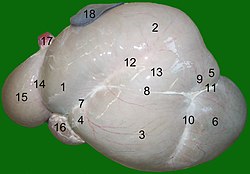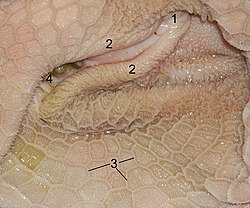Reticulum
The reticulate stomach (or hood , lat. Reticulum ) is the most forward section of the ruminants' stomach . The name 'reticulum' is derived from the ridged folds of the mucous membrane ( Cristae reticuli ), which delimit four- to hexagonal dome cells ( Cellulae reticuli ) and give the inner surface of the reticulum a honeycomb - or net-like appearance. The reticulum is located on the left in the abdominal cavity , in front of the rumen and directly behind the diaphragm . Since the functions of the reticulum and rumen are closely intertwined, both are also summarized under the term ruminoreticulum .
The reticulate stomach plays an important role as a separator from solid and already fermented feed materials. The former are channeled back into the rumen , the latter into the leaf stomach . It also enables ruminant chewing: following a longer hood contraction, food is transported back into the oral cavity by anti-peristaltic contractions of the esophagus , where it is chewed and swallowed again.
From the esophageal opening to the opening in the omasum ( ostium reticulo-omasicum ), the aided by two lips muscular reticulum portion extends the stomach groove ( sulcus reticuli ). This is out of date also known as the gullet . In veal and lamb, the reticulum troughs reflexively closes into a tube when they consume liquid food ( hood trough reflex ). This prevents milk from getting into the rumen and fermenting incorrectly there, which would lead to diarrhea . This hood groove reflex disappears again later.
The mostly less selective feed intake of the cattle often leads to foreign objects (e.g. nails, parts of fence wire) being ingested with the feed and triggering a so-called foreign body disease. The foreign bodies usually collect in the reticulum and can pierce its wall when the hood contracts. The consequences can include liver abscesses or pericarditis. For prevention, cage magnets can be inserted into the reticulum.
literature
- Franz-Viktor Salomon: stomach, ventriculus (gaster). In: Salomon u. a. (Ed.): Anatomy for veterinary medicine . 2nd ext. Edition. Enke-Verlag, Stuttgart 2008, ISBN 978-3-8304-1075-1 , pp. 272-293.

